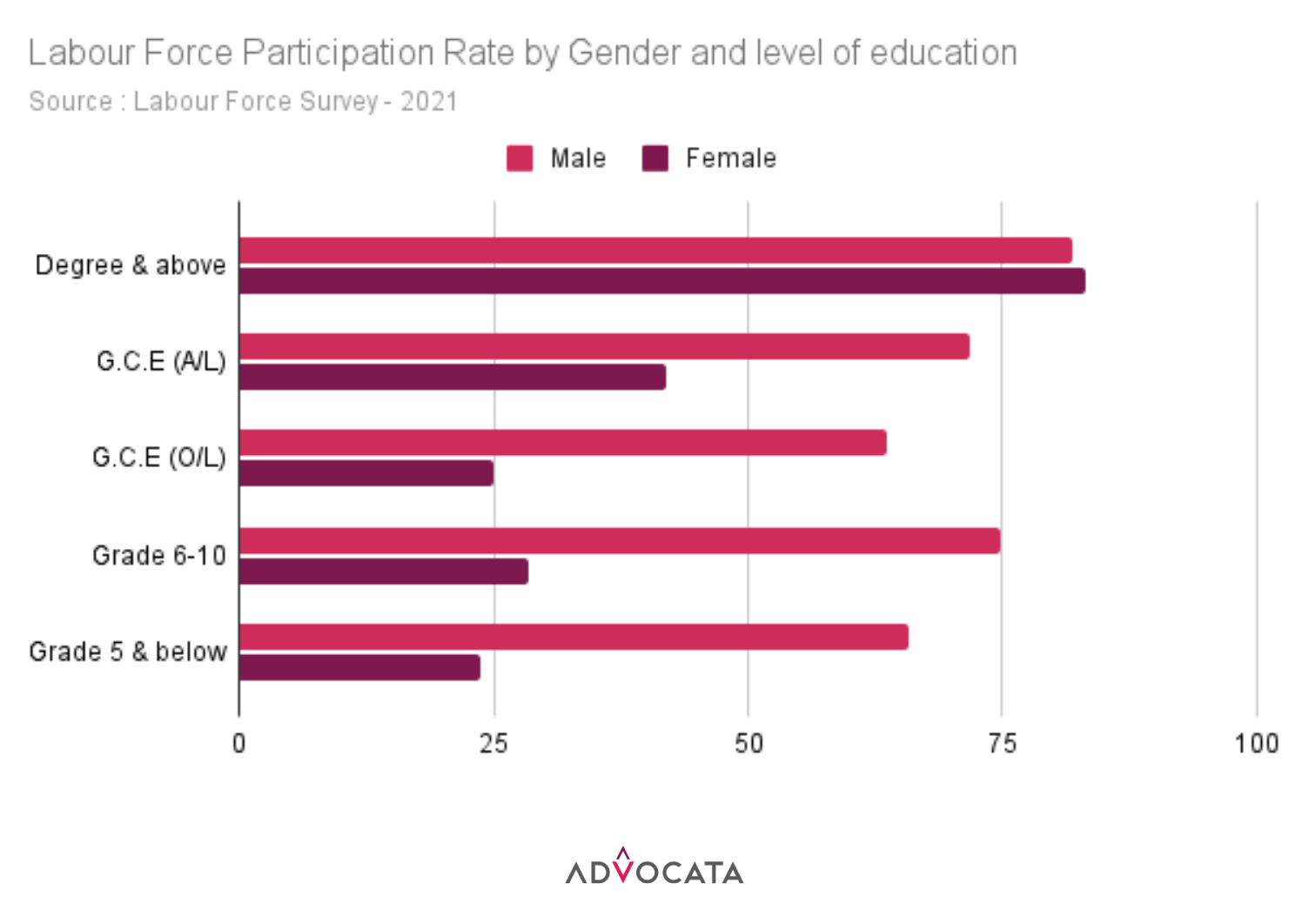Photo courtesy of Solidarity Center
The issue of female labor force participation in Sri Lanka has remained a subject of discussion for several decades yet tangible progress in improving it has been elusive. As the country grapples with its most severe economic crisis since gaining independence, it is important to take a hard look at the labor force to maximize its potential in overcoming the economic crisis.
Sri Lanka is approaching its last stages of its demographic dividend characterized by a significant proportion of its population falling within the working age bracket (typically aged 15-64) in relation to the dependent age categories, the aged and the children. According to the Asian Development Bank, Sri Lanka’s working age population is expected to reach its peak around 2027. This presents a unique opportunity for us to strengthen economic prospects by using the right socioeconomic policy mix, similar to how the Tiger economies like Singapore and Hong Kong have harnessed their demographic dividends to advance their economic growth.
Importantly, a substantial portion of this working age population comprises highly educated and women who are living longer. Hence necessary interventions must be made to harness their economic potential.
Current status of the labour market
According to the 2021 Labor Force Survey, Sri Lanka’s total labor force comprises 8.5 million individuals with 65% of them being male. The overall labor force participation rate (LFPR) hovers around 50%, revealing a significant gender gap that has persisted since the early 2000s. As of 2021, the male labor force participation rate in the country stands at 71% whereas the female labor force participation rate is considerably lower at 31.8%. This enduringly low female labor force participation rate, spanning almost a decade, necessitates increased attention and intervention from the government. It represents an untapped potential within the economy that demands harnessing for the nation’s benefit.
When examining the female labor force participation, it becomes evident that a significant proportion of females are employed in the estate sector, constituting 42.6% of the female workforce. In 2021, a substantial majority of the economically inactive population were females, accounting for approximately 73.3%. Interestingly, among these economically inactive women, 59.4% cited engagement in household work as their primary reason for not participating in the labor force. This sheds a light on household responsibilities as the main contributing factor preventing women from entering the workforce.
Education status of the labour market
Sri Lankan women tend to achieve higher levels of education compared to men. However, this educational advantage hasn’t translated into higher levels of participation in the labor force. To illustrate this relationship between labor force participation and education, the chart below provides a clear visual representation of the situation.

This diagram highlights two important points. Firstly, it reveals that a significant majority of women who participate in the labor force (83.2%) possess degrees or higher levels of education. This suggests that women are more likely to apply for jobs that align with their skill set and education level.
Secondly, it underscores a distinct contrast when it comes to men. Even if men have an education level of Grade 5 or below, a substantial portion (65.7%) still actively contribute to the economy. This disparity suggests that women with lower levels of education face greater challenges or barriers when it comes to workforce participation compared to their male counterparts.
This statistic also serves as a clear illustration of the traditional societal norm of men being the breadwinner, which leads to men having higher labor force participation rates irrespective of their educational levels. On the other hand, women, despite their advanced educational qualifications, may encounter societal pressures or constraints that discourage them from seeking or maintaining employment. Unemployment remains a significant challenge with the highest rates observed among women holding education levels at Advanced Level and above. This represents a substantial untapped pool of potential in the labor market.
Reasons for low female labour force participation
The low female labor force participation rate can be attributed to a range of socioeconomic factors.
A primary factor that discourages women from actively contributing to the economy is the significant burden of care responsibilities they bear. This care work encompasses a broad range of household tasks from cooking and cleaning to childcare and caring for the elderly. According to the 2017 Time Use Survey, women spent nearly four hours more per day on unpaid care work and domestic services compared to men. For many decades, there has been a prevailing societal stereotype that women are primarily responsible for managing households while men are expected to be the breadwinners outside the household. This division of labor is a key reason why women with the qualifications and capabilities to pursue employment opportunities often choose to stay at home, while men even with lower levels of education enter the labor market.
Another significant factor is the existing legal barriers in Sri Lanka. The two prominent legal constraints are restrictions on nighttime work and the absence of recognition for part time employment. While these legal provisions may have initially aimed to protect women, they inadvertently discriminate by limiting their employment opportunities and earning potential. For example IT/BPM sector employment is affected by the 1954 Act which only permits women over the age of 18 to work till 8 pm. The current statutory regimes governing employee rights fail to recognize part time work. This oversight leads to a reluctance by employers to hire part time workers as they are entitled to the same benefits as full time workers.
The absence of adequate social infrastructure such as quality child care centers and comprehensive parental leave policies contributes significantly to the low female labor force participation rate. Approximately 80% of child care centers are privately operated. This situation creates a barrier to accessing quality and affordable child care facilities, making it financially challenging for skilled women to participate in the labor force as many opt to stay at home to care for their children due to these constraints.
As highlighted in an ILO report the presence of skill mismatch in the labor market since the early 1970s contributes as another reason. This skill mismatch exists because the country’s education system does not adequately prepare graduates with the skills required by the job market. There is a notable disconnect between the courses offered by universities and the competencies needed by the private sector.
This mismatch also contributes as a reason for the high levels of youth unemployment and the prevalent issue of arts degree holders struggling to find employment. A staggering 43.9% of unemployed graduates possess degrees in the arts. Notably, the majority of arts degree holders are women. This situation underscores a disconnect between the demand and supply within the labor market. It suggests that the current education system is not adequately preparing graduates with the skills and qualifications needed to meet the demands of available job opportunities.
Addressing these barriers is vital to improving the labor force participation rates, especially among women.
Policy Recommendations
- Recognize part time work under the existing statutes and provide needed benefits such as annual leave and remove provisions which restricts women from working at night.
- Utilize local government mandates via by-laws to enact local legislation to set up standardized and regularized day care centers while encouraging public-Private partnerships in providing care for children by utilizing existing infrastructure.
- Introduce more courses and degrees which are required by the private sector. This should be specially done by focusing on arts graduates.
The effectiveness of these policies would be limited if the need for a shift in people’s mindsets was not addressed. While Sri Lanka has made progress in challenging gender stereotypes, there is still much work to be done. Initiating change, particularly within the education system, presents a promising starting point. The prevailing patriarchal system can be challenged and dismantled through education, which has the power to instill in both men and women the belief that predefined gender roles are unnecessary.
Thathsarani Siriwardana is a Research Assistant at Advocata Institute. The opinions expressed are the author’s own views.

